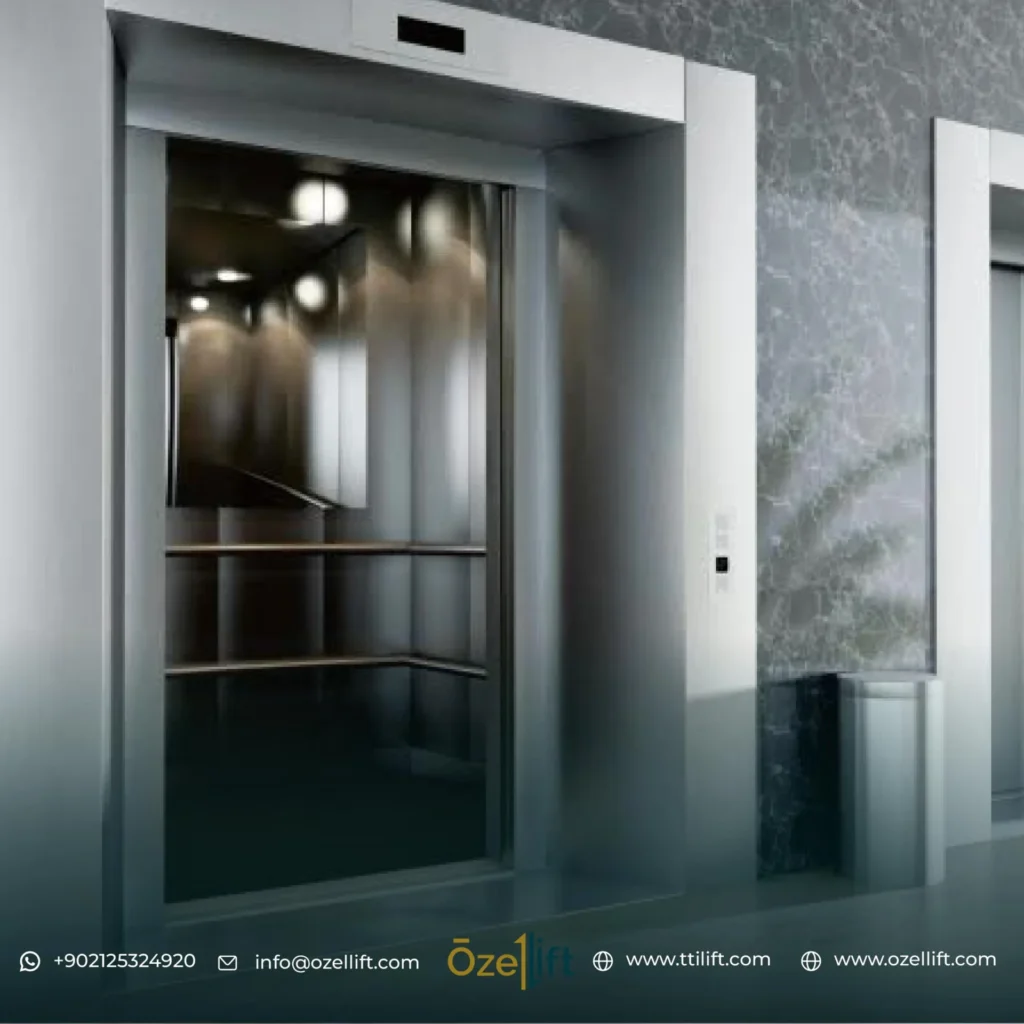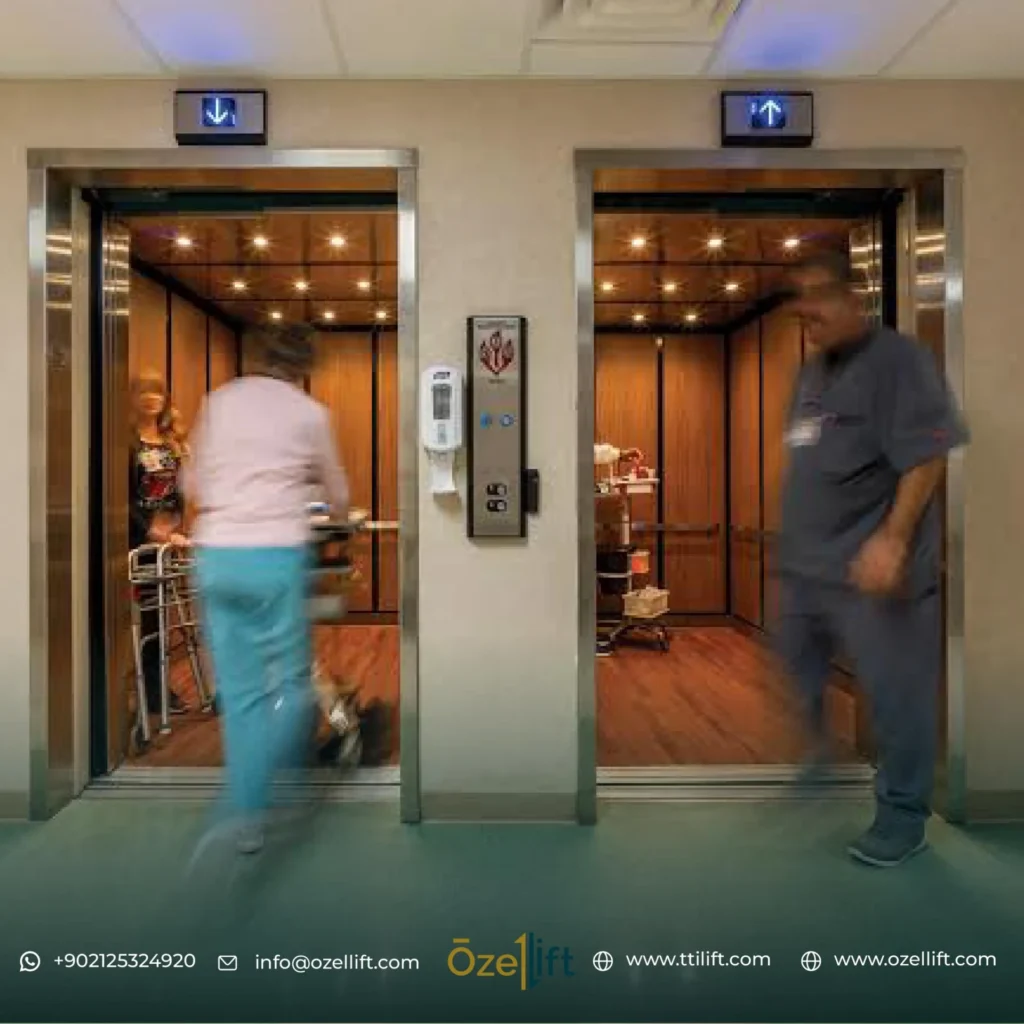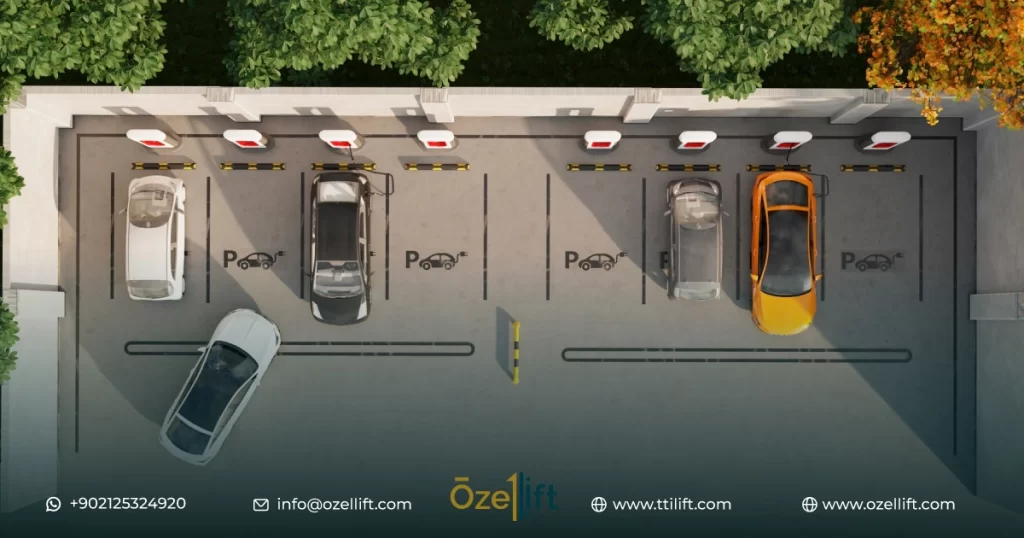Passenger elevators are vertical transportation devices used to move people between floors in high-rise buildings, commercial complexes, and residential structures. They provide a safe and comfortable means of transportation, especially beneficial for individuals with disabilities, facilitating efficient and convenient movement within modern buildings.
Find out all the required information about passenger elevators, their features and prices between the parts of the article with the experts of Özellıft Company.
Passenger elevator prices in the world
Passenger elevator prices vary depending on the type of elevator, its size, load, speed, and other features. In general, the prices of passenger elevators in the world range between US$10,000 and US$1,000,000.
Here are some examples of passenger elevator prices in the world:
- Small electric elevator: A small electric elevator that seats a few people can range between $10,000 and $20,000.
- Average electric elevator: The price of an average electric elevator that can accommodate an average number of people can range between $20,000 and $50,000.
- Large escalator: The price of a large escalator that can accommodate a large number of people or goods can range between US$50,000 and US$1,000,000.
- In addition to the cost of purchasing a lift, there are also additional costs associated with installing and maintaining the lift. Installation costs can range between 10% and 20% of the elevator purchase cost, and maintenance costs range between 1% and 2% of the elevator value annually.
Factors affecting passenger elevators Prices
There are many factors that affect passenger elevators, including:
- Elevator type: There are two main types of elevators: electric elevators and hydraulic elevators. Electric elevators and hydraulic elevators differ in the way they operate, resulting in differences in cost, performance, and safety.
- Elevator size: Elevators vary in size depending on their purpose. Elevators used in residential buildings tend to be smaller than elevators used in commercial or industrial buildings.
- Elevator payload: Elevator payload determines how many people or goods the cab can accommodate. Elevators with larger payloads tend to be more expensive than elevators with smaller payloads.
- Elevator speed: Elevator speed determines the time it takes the elevator to reach different floors. Faster elevators tend to be more expensive than slower elevators.
- Elevator Features: Elevators can be customized with a variety of features, such as automatic doors, a sound system, or a motion control system. These features can add to the cost of the elevator.
- Location: Cost and regulations regarding elevators vary by location. For example, elevators in the United States may be more expensive than elevators in India.
- Maintenance: Elevators require regular maintenance to maintain their safety and efficiency. Maintenance costs can affect the total cost of owning an elevator.
When choosing an elevator, it is important to consider all of these factors. It is also important to get quotes from several different companies before making a purchasing decision.
Know more about
Hospital elevators
Observation Elevators
what are passenger elevators?
Passenger elevators are vertical transportation devices used to transport people between different floors in high-rise buildings, commercial and residential complexes. It is an important means of transportation in the modern era, as it facilitates movement between different floors and makes it more efficient and comfortable.
Passenger elevators are expected to continue to play an important role in our daily lives. As taller buildings continue to rise, passenger elevators will become more necessary than ever, and new technologies will be developed to make passenger elevators more efficient and safe.
Passenger elevator components
Passenger elevators consist of a variety of components, including:
- Cabin: It is the part that moves up and down. The cabin consists of a metal structure supported by columns. The cab also contains a floor, seats, barriers, lights and control systems.
- Well: This is the place where the cab moves. The well consists of a vertical hole surrounded by two walls. The well also has cabin holders and safety systems.
- Engine: It is the engine that raises and lowers the cab. The engine is usually located in the engine room at the top of the well.
- Control system: The system that controls the movement of the cab. The control system is usually located in the engine room at the top of the well.
Below is a detailed explanation of each of these components. Continue with the following paragraphs.
Passenger elevator cabins
The cabin is the part that moves up and down. The cabin consists of a metal structure supported by columns. The cab also contains a floor, seats, barriers, lights and control systems.
Know more about
Elevator ceilings
Elevator flooringing
Elevator doors
Passenger elevator well
The well is where the cab moves. The well consists of a vertical hole surrounded by two walls. The well also has cabin holders and safety systems.
- Walls: The wall of the well consists of solid materials such as concrete or steel. The walls help stabilize the well and prevent the cabin from falling.
- Cab Stands: Cab stands consist of rollers or tracks that allow the cab to move up and down.
- Safety systems: Elevators contain a variety of safety systems to prevent accidents. Safety systems usually include brakes, backup wires, and speed limit systems.
Passenger elevator motor
The motor is the motor that raises and lowers the cab, and is usually located in the engine room at the top of the well.
Engine type
There are two main types of motors used in elevators: electric motors and hydraulic motors.
- Electric Motor: The electric motor works by using electrical energy to raise and lower the cab.
- Hydraulic Motor: The hydraulic motor works by using hydraulic fluid to raise and lower the cab.
Electric elevator control system
The control system is the system that controls the movement of the cab. The control system is usually located in the engine room at the top of the well.
Control system components
The control system consists of a variety of components, including the control panel, keypads, and sensors.
- Control panel: The control panel contains electronic components that control the movement of the cab.
- Keypads: Some elevators have keypads that allow passengers to control the movement of the cabin.
- Sensors: Elevators contain a variety of sensors that allow the system to control the movement of the cab. Sensors typically include motion sensors, speed sensors, and security sensors.
- Passenger elevator safety
Passenger elevators are subject to strict safety standards and are equipped with a variety of safety systems aimed at preventing accidents – let’s discuss safety systems in passenger elevators in the next paragraph.
Types of elevator cabins
Elevator cabins come in various styles! Basic options include painted steel or stainless steel. For a luxurious touch, etched designs or panoramic glass walls are available. The type you choose depends on budget, building style, and desired passenger experience.
Safety systems in passenger elevators
- Cab Brakes: Brakes prevent the cab from falling over if an engine failure occurs. Backup cab wires: Backup cab wires provide additional support to the cab in the event of a malfunction in the main wires.
- Speed limit systems: Speed limit systems stop the cab if it exceeds the set speed. Safety sensors: Safety sensors are used to detect dangerous situations and stop the cab. Safety sensors typically include motion sensors, speed sensors, and security sensors.
- In addition to these basic systems, passenger elevators can also include additional safety systems, such as:
- Alarm system: The alarm system emits a sound or light to alert passengers in the event of a malfunction.
- Intercom System: The intercom system allows passengers to communicate with emergency personnel in the event of a malfunction.
- Backup Lighting System: Backup lighting system provides lighting in the event of a power outage.
- Passenger elevators are regularly inspected by Özellıft certified technicians to ensure that they are operating properly and safely.
passenger elevators importance
Passenger elevators play an important role in our daily life. They make it possible to move easily between different floors in high-rise buildings, commercial and residential complexes. It also provides a safe and comfortable means of transportation for people with disabilities.
Here are some of the most important benefits of passenger elevators:
- It facilitates movement between different floors in high-rise buildings
- Passenger elevators make it possible to reach the upper floors of high-rise buildings easily and safely. Without elevators, it would be extremely difficult or even impossible to reach these floors.
- They make buildings more efficient and comfortable
- Passenger elevators help make buildings more efficient and comfortable. It allows people to access different floors quickly and easily, reducing the time and effort required to move around.
- Provides a safe and comfortable means of transportation for people with disabilities
- Passenger elevators are essential for people with disabilities. It provides a safe and comfortable means of transportation for people who cannot walk easily.
Know more about
Freight elevators
Car elevators
Home elevators
Uses of passenger elevators
Passenger elevators are vertical transportation devices used to transport people between different floors in high-rise buildings, commercial and residential complexes. It is an important means of transportation in the modern era, as it facilitates movement between different floors and makes it more efficient and comfortable.
Passenger elevators are used in a variety of applications, including:
- High-rise buildings: Passenger elevators are used in high-rise buildings to allow people to reach the upper floors easily and safely. Without elevators, it would be extremely difficult or even impossible to reach these floors.
- Commercial complexes: Passenger elevators are used in commercial complexes to allow customers to easily reach all floors. It is also used to transport goods.
- Residential Buildings: Passenger elevators are used in residential buildings to allow residents easy access to all floors. It is also used to transport goods.
- Hospitals: Passenger elevators are used in hospitals to allow patients and staff to easily access all departments. It is also used to transport medical equipment.
- Airports: Passenger elevators are used at airports to allow passengers easy access to all gates. It is also used to transport luggage.
- Industrial Facilities: Passenger elevators are used in industrial facilities to allow employees easy access to all departments. It is also used to transport raw materials and finished products.
Passenger elevators play an important role in our daily life, as they make it possible to move easily between different floors in high-rise buildings, commercial and residential complexes. It also provides a safe and comfortable means of transportation for people with disabilities.
Types of passenger elevators
There are two main types of passenger elevators:
Electric elevators: They are the most common type. These elevators operate using electric motors to raise and lower the cab.
Hydraulic elevators: These elevators operate using hydraulic fluids to raise and lower the cab.
Electric lifts
Electric elevators are the most common type of passenger elevator. These elevators operate using electric motors to raise and lower the cab.
Electric elevators consist of a variety of components, including:
- Cabin: It is the part that moves up and down.
- Well: This is the place where the cab moves.
- Engine: It is the engine that raises and lowers the cab.
- Control system: The system that controls the movement of the cab.
Hydraulic elevators
Hydraulic elevators are a less common type of passenger elevator. These elevators operate using hydraulic fluid to raise and lower the cab.
Hydraulic elevators consist of a variety of components, including:
- Cabin: It is the part that moves up and down.
- Well: This is the place where the cab moves.
- Hydraulic motor: This is the motor that raises and lowers the cab.
- Control system: The system that controls the movement of the cab.
Differences between electric elevators and hydraulic elevators
Electric elevators and hydraulic elevators differ in a number of aspects, including:
- Speed: Electric lifts tend to be faster than hydraulic lifts.
- Carrying capacity: Electric elevators can bear heavier loads than hydraulic elevators.
- Cost: Electric lifts tend to be more expensive than hydraulic lifts.
- Maintenance: Electric elevators require more maintenance than hydraulic elevators.
Shapes and sizes of passenger elevators
Passenger elevators vary in shape and size depending on the application and user needs.
Shapes
Passenger elevators are available in a variety of styles, including:
- Rectangular: This is the most common shape.
- Square: These elevators feature a more elegant and modern design.
- Circular: These elevators feature a more modern and advanced design.
Sizes
Passenger elevators are available in a variety of sizes, including:
- Small: These elevators are characterized by their small size, which makes them ideal for use in small buildings or residential buildings.
- Medium: These elevators are characterized by their medium size, which makes them ideal for use in commercial buildings or multi-story buildings.
- Large: These elevators are distinguished by their large size, which makes them ideal for use in high-rise buildings or industrial buildings.
Factors affecting the shape and size of the passenger elevator
Factors that affect the shape and size of a passenger elevator include:
- Capacity: Capacity determines the number of people or goods that the cab can accommodate.
- Distance between floors: The distance between floors determines the height of the shaft, and thus the size of the elevator.
- Available space: The available space in the building determines the size of the elevator.
Examples of passenger elevator shapes and sizes
Here are some examples of passenger elevator shapes and sizes:
- Apartment building: Apartment buildings may have small or medium-sized rectangular elevators.
- Commercial Building: Commercial buildings may have medium or large sized rectangular elevators.
- Famous Building: Famous buildings such as hotels or museums may have large rectangular, square, or circular elevators.
- Industrial Building: Industrial buildings may contain large rectangular elevators to carry heavy equipment.
The future of passenger elevators
It is expected that passenger elevators will continue to play an important role in our daily lives in the future. As taller buildings continue to rise, passenger elevators will become more necessary than ever. New technologies will also be developed to make passenger elevators more efficient and safe.
Here are some potential trends in the field of passenger elevators:
- Faster, more efficient elevators: Passenger elevator manufacturers are conducting research and development to create faster, more energy efficient elevators.
- Safer Elevators with Improved Safety Systems: Passenger elevator manufacturers are also conducting research and development to create safer elevators with improved safety systems.
- Eco-friendly elevators: Eco-friendly elevators are being developed that use renewable energy sources and other technologies to reduce environmental impact.
- Elevators designed specifically for the special needs of people with disabilities: Elevators designed specifically for the special needs of people with disabilities are being developed, making them easier and safer to use.
These are just some of the potential trends in the passenger elevator industry. As technological advancements continue, passenger elevators are sure to become more efficient, safe and environmentally friendly in the future.
Features of passenger elevators
Passenger elevators have many advantages, including:
- Comfort: Passenger elevators provide a comfortable and easy way to move between different floors in the building.
- Efficiency: Passenger elevators can transport large amounts of passengers in a short period of time, which helps improve building efficiency.
- Safety: Passenger elevators are designed with a variety of safety features to ensure passenger safety.
- Versatility: Passenger elevators are available in a variety of sizes, shapes and capacities to meet a variety of needs.
Here are some details about each of these benefits:
Comforts
Passenger elevators provide a comfortable and easy way to move between different floors in the building. Passengers can use elevators instead of stairs, saving them effort and fatigue. Passenger elevators can also be useful for people with disabilities, as they can easily reach different floors without having to use stairs.
Efficiency
Passenger elevators can transport large amounts of passengers in a short period of time, which helps improve building efficiency. For example, one elevator can carry up to 20 people at a time, which equates to up to 200 people per hour.
Safety
Passenger elevators are designed with a variety of safety features to ensure passenger safety. These features include:
- Brake system: The brake system prevents the elevator from falling if the motor fails.
- Fire protection system: The fire protection system prevents the elevator from working if there is a fire.
- Alarm system: The alarm system warns passengers if the elevator malfunctions.
Diversity
Passenger elevators are available in a variety of sizes, shapes and capacities to meet a variety of needs. For example, small passenger elevators are available for use in residential buildings, while large passenger elevators are available for use in high-rise buildings. Passenger elevators specially designed for transporting goods or people with disabilities are also available.
Özellıft Company – the best for passenger elevators
Özellıft Company is a leading company in the field of passenger elevators in Egypt. With over 20 years of experience in designing, manufacturing, installing and maintaining passenger elevators, Özellıft is committed to providing the best quality passenger elevators at competitive prices. The company’s elevators meet all international standards for safety and efficiency.
Özellıft elevators have many advantages, including:
- Quality: Özellıft elevators are manufactured using high-quality materials and advanced technologies.
- Efficiency: The company’s elevators are characterized by high efficiency performance and low energy consumption.
- Safety: The company’s elevators have a variety of safety features to ensure the safety of passengers.
- Diversity: The company’s elevators are available in a variety of sizes, shapes and capacities to meet a variety of needs.
If you are looking for the best passenger elevators in Egypt, contact us now – for more information about Özellıft elevators, or to request a quote, all you have to do is contact us so that the technical team can answer all your questions.



